WALKTHROUGH INSPECTION VIDEOS ARE HERE!
|
To help owners/operators train new employees on walkthrough inspections, we have created two short videos found on the bottom of our webpage at: https://deq.mt.gov/twr/Programs/ust
Monthly walkthrough inspection video: https://youtu.be/XkvaY87js8A
Annual walkthrough inspection video: https://youtu.be/zcAfz6l8UYE
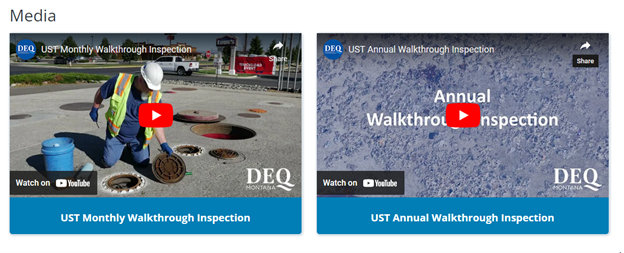 Benefits of 30-Day Walkthrough Inspections
Some of the benefits of Walkthrough inspections are:
-
understanding your system better
-
finding problems before they develop into something that can threaten the system
-
protecting the environment
-
avoid losing costly fuel
-
giving you peace of mind
We've been hearing examples of issues that were discovered during 30-Day Walkthrough Inspections:
Example #1: Maintenance personnel found upon visual inspection for the 30-Day Walkthrough that turbine sump had 16” of diesel #2 in it. This was reported immediately, and the product was shut down until the necessary repairs could be completed. If this wasn’t found during the Walkthrough Inspection, the leak could have caused diesel #2 to leak out of the sump creating a fuel release.
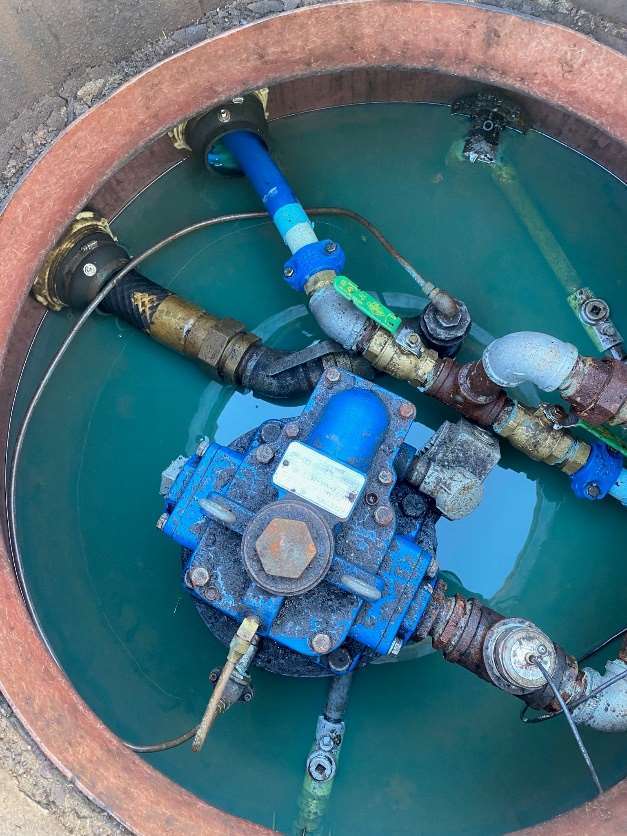 Example #2: A facility reported that there was a leak in a diesel product line found during the 30-Day Walkthrough Inspection. The location immediately shut down the High Flow Diesel #2 until repairs could be made. It turned out that a dispenser was leaking on a union causing a sump to fill up with fuel then run back into the turbine sump.
Example #3: A facility was performing the 30-Day Walkthrough Inspection when they were taking the readings off the rectifier, the cathodic protection amp reading was reported at zero. A cathodic protection engineer was hired to survey the site. The engineer explained the issues and what repairs needed to be completed. Without cathodic protection the underground tanks and associated piping are not protected which could cause premature erosion of the tanks and piping which could cause leaks into the soil.
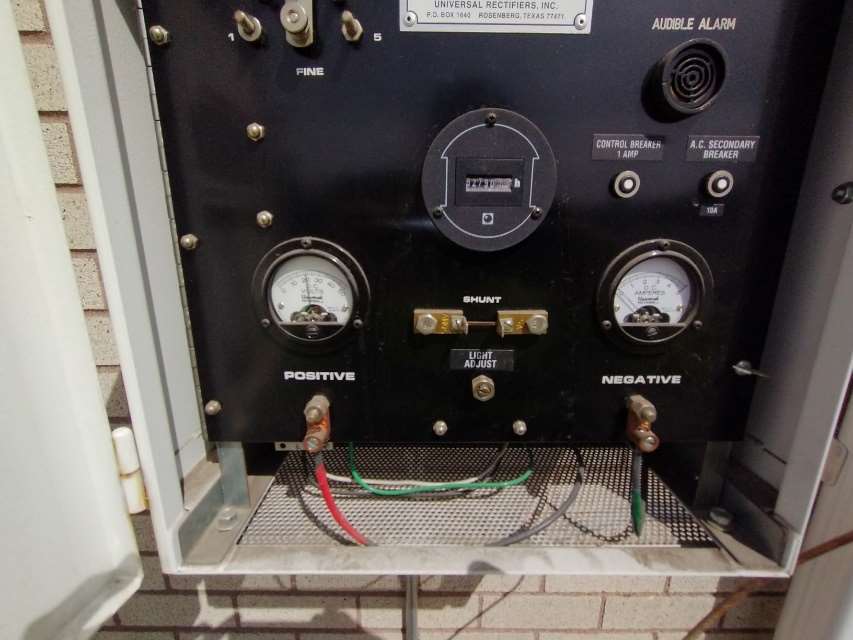 Example #4: During the 30-Day Walkthrough Inspection, the maintenance personnel reported the need for a new seal cap for a brine spill bucket. During the Walkthrough Inspections, the maintenance personnel inspect all lids, caps, and make sure there are the appropriate locks on each device.
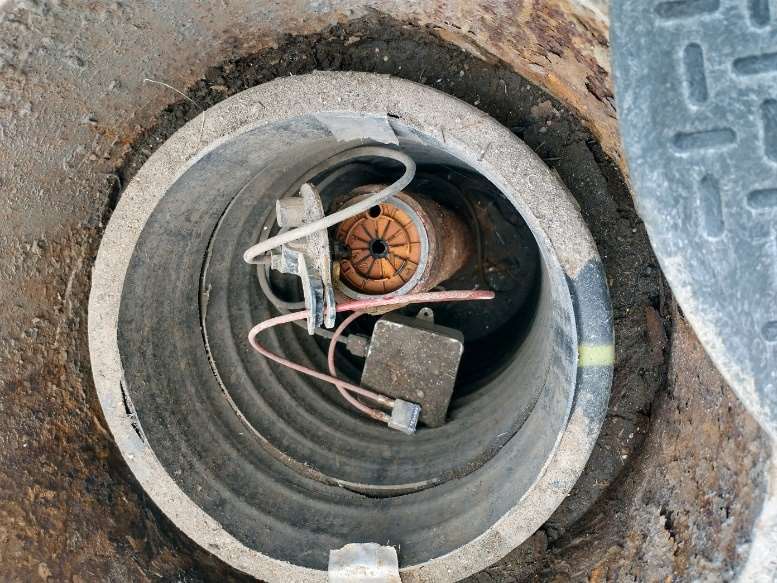 Example #5: During a 30-Day Walkthrough Inspection, the maintenance personnel reported that one of the dispensers had a meter gasket leak. The location immediately shut off the shear valve to keep any fuel from being dispensed. A vendor was dispatched to make the needed repairs. Without the visual from the inspection, this leak could have gone on for longer which could cause a fuel release. The smallest of leaks, one to two drops per second is equivalent to 1.2 gallons per day and 36 gallons per month.
Additional Examples of issues found during a 30-Day Walkthrough Inspections:
- Liquid in sump with the ATG alarm not going off. The ATG needed to be programmed again to ensure that alarms go off when liquid enters the sump.
- Multiple fuel seeps on dispenser hoses. Hoses had to be replaced.
- Bulges in spill buckets. The spill buckets had to be replaced.
Investigating Petroleum Vapor Intrusion Potential – the Next Step: Sampling
Methods for investigating the Petroleum Vapor Intrusion (PVI) potential at a petroleum release site using appropriate screening distances were summarized in MUST News July 2022 (Petroleum Vapor Intrusion Screening). Sampling is the next step in the investigation process for potential PVI when those screening methods can not eliminate PVI risks.
Indoor air sampling combined with ambient outdoor air sampling should be conducted if any part of a building’s foundation is in direct contact with petroleum contamination or if any of the following conditions are identified:
-
Basement, cellar, or crawl space is dirt floored.
-
Open cracks in building foundation, basement walls, or floor.
-
Sump is present.
-
Utility corridor(s) intersect contaminated soil or groundwater.
-
Other preferential pathways connecting a vapor source to a building.
-
Odors/vapors are present.
Phased sampling should be conducted when the building is not in direct contact with petroleum contamination or if any of the following occurrences or conditions are identified:
-
Lead scavengers 1,2 DCA or EDB are present.
-
Release-associate petroleum contained greater than 10 % ethanol or other alcohol.
-
Contaminant plume is expanding or advancing or is there a continued source of release.
-
Subsurface soils have high concentrations of organic matter (i.e., peat soils) or excessively dry soils (less than 2% by volume or 1.2% by weight moisture).
-
Large buildings are present (greater than 66 feet on shortest side).
Phased PVI sampling should begin with an Exterior Soil-Vapor Phase. Install exterior site-specific soil vapor probes to sample and evaluate potential PVI exposure pathways. If the exterior soil-vapor data cannot rule out the PVI exposure pathway or site-specific conditions require additional investigation, then continue additional sampling phases as follows.
-
Sub-slab Phase – Install interior sub-slab sampling points and conduct sampling and evaluation of PVI beneath buildings and structure.
-
Indoor Air Phase – Required when sub-slab sampling cannot rule out the PVI exposure pathway. Conduct sampling in crawlspace, sub-slab, main-floor, and other indoor air-sampling and evaluate PVI.
-
Vacant Lot Phase – Vacant properties that are being (or will be) redeveloped should be sampled for petroleum hydrocarbons in soil vapor using nested soil vapor probes to determine the vertical attenuation of hydrocarbons.
Laboratory Analysis – Initially all PVI samples should be analyzed using the TO-15 Method and Air-phased Hydrocarbon method. The TO-15 Method should include the following analytes: benzene, ethylbenzene, toluene, xylenes, and naphthalene. Depending on the contaminants observed in soil and groundwater at the site, additional analytes may need to be included in the TO-15 Method such as methyl tert-butyl ether (MTBE), 1,2 Dichloroethane (DCA), 1,2 Dibromoethane (EDB), and 1,3 Butadiene.
Evaluating Laboratory Data for Soil Vapor – Soil vapor and sub-slab analytical data should initially be compared to the appropriate DEQ/EPA Regional Screening Levels (RSL) and then can be adjusted using an attenuation factor of .03. EPA’s Vapor Intrusion Screening Level (VISL) calculator is also a useful tool for adjusting screening levels for sub-slab and soil vapor data that exceeds initial screening level and the calculator has the attenuation factor built into it. EPA’s VISL calculator can be found on their website at Vapor Intrusion Screening Level Home (ornl.gov).
Evaluating Laboratory Data for Indoor Air – Indoor air analytical data should initially be compared to Table 1 of DEQ’s APH Screening Level Calculator. All petroleum compounds that exceed Table 1 RSLs should be entered into Table 2 to get the site-specific adjusted screening levels. DEQ’s APH Screening Level Calculator can be found on our website at NEW aphvisl_calc_20160608 (1).xlsx (live.com).
Additional information regarding PVI sampling topics covered in this article, along with other topics such as proper installation of probes, leak tracer testing, etc., can be found in Montana DEQ’s Vapor Intrusion Guide found on our website at MontanaVI_Guide_FINAL.pdf (mt.gov).
Petroleum Storage Tank Systems and Petroleum Tank Releases: Summary from January 1, 2021 thru September 30, 2022
DEQ Underground Storage Tank (UST) Section – Permits UST Systems Installation, Operation/Compliance, Decommissioning/Removal
-
UST Section oversees new tanks being installed and has a robust program for release prevention.
-
UST Section Regulates 3,755 tanks and 1,227 facilities (UST Public Records Report, January 12, 2022)
-
Issued permits for UST System Installation:
-
135 tanks were installed - from Jan. 1, 2021, thru Sep. 30, 2022.
-
Issued permits for UST removal:
-
108 tanks were removed - from Jan. 1, 2021, thru Sep. 30, 2022.
DEQ Petroleum Tank Cleanup Section (PTCS) – Remediation of Petroleum Tank Releases – Confirmation, Investigation, Cleanup, and Closure.
-
85 Closed Petroleum Releases - from Jan. 1, 2021, thru Sep. 30, 2022.
-
53 New Confirmed Petroleum Releases - from Jan. 1, 2021, thru Sep. 30, 2022.
-
Source & Cause of Petroleum Releases:
-
18 Releases - Piping / Dispensers (physical damage, vehicle overfill, spills, malfunction, human error)
-
15 Releases - UST / AST (corrosion, failed component, spill/overfill, historical, human error)
-
15 Releases - Historical Contamination / Other: (historical contamination, unknown cause)
-
5 Releases - Turbine / Secondary Containment / Vent line: (malfunction or failed component)
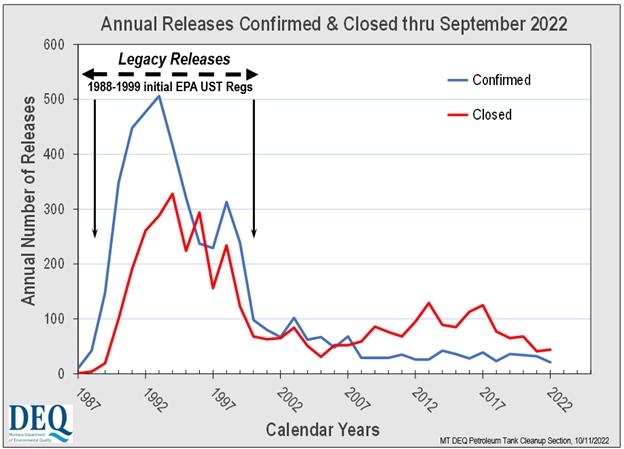 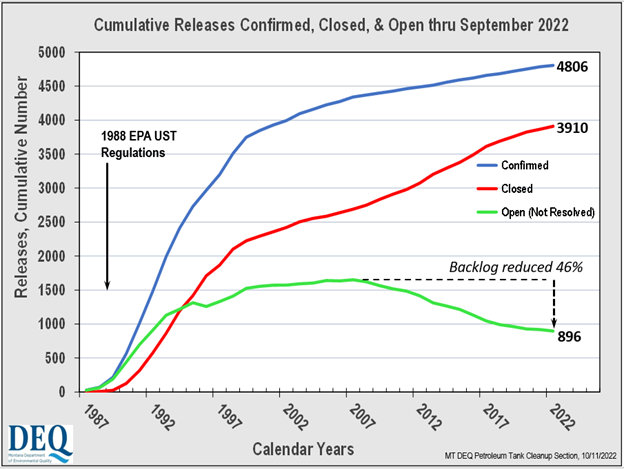  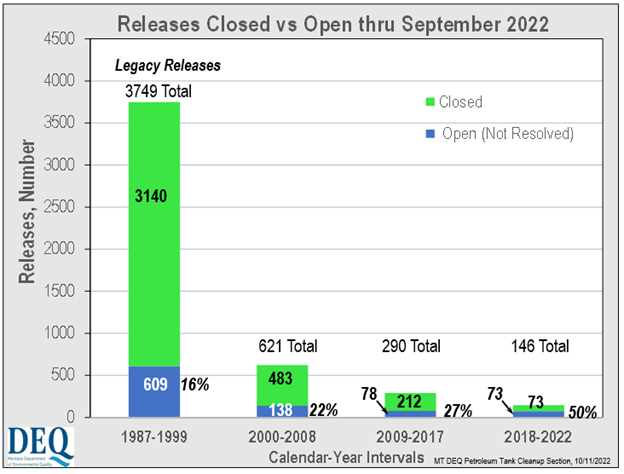 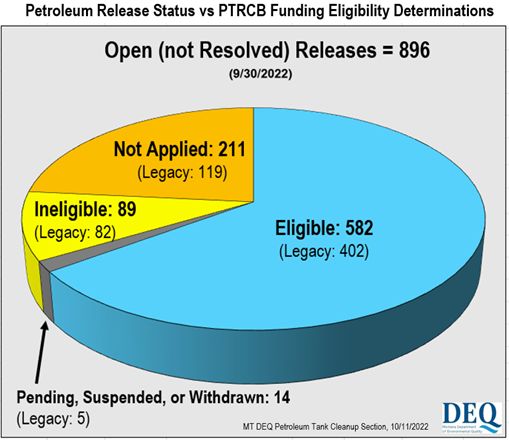 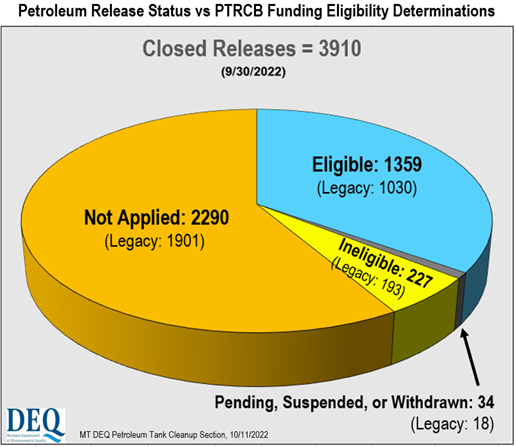 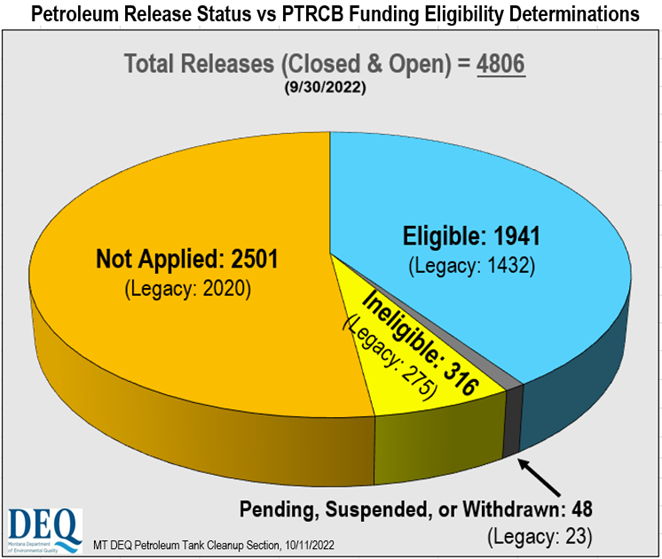 Aboveground Storage Tank (AST) Regulations
-
Montana DEQ UST program regulates storage tank systems that fit the legal definition of an underground storage tank. That includes Aboveground Storage Tanks (ASTs) that have connected underground product piping. If an aboveground tank has underground piping, it is treated as an Underground Storage Tank (UST) and would be subject to Montana UST regulations. However, it does not include farm or residential tanks or piping that were installed as of April 27, 1995 that have a capacity of 1,100 gallons or less that is used for storing motor fuel for noncommercial purposes or for storing heating oil for consumptive use on the premises where it is stored. Click here for definition of an UST.
-
If the AST is completely above ground with above ground piping, then the AST is not regulated by the Montana DEQ UST program. ASTs are required to meet the State/Federal/International Fire Codes set forth by the State Fire Marshal’s office. The State Fire Marshal’s Office can be contacted at (406) 791-2706. Cities and counties may also have regulations for ASTs so check with your local city and county for more information. Your local fire department, fire chief, or Deputy Fire Marshal is a good resource for the local regulations.
-
Facilities with aboveground storage tanks (ASTs) holding oils of any kind may be subject to U.S. EPA's Spill Prevention, Control, and Countermeasure (SPCC) regulation (40 CFR Part 112). The SPCC regulation does not specifically use the term AST, but rather includes ASTs under the term bulk storage container.
-
A bulk storage container is “any container used to store oil. These containers are used for purposes including, but not limited to, the storage of oil prior to use, while being used, or prior to further distribution in commerce. Oil-filled electrical, operating, or manufacturing equipment is not a bulk storage container.” Oil-filled equipment may also be subject to the SPCC regulation and should be included with the bulk storage container capacity when determining the facility’s overall aggregate oil storage capacity. For more information on whether SPCC applies to your facility or not, go to: https://www.epa.gov/oil-spills-prevention-and-preparedness-regulations/does-spill-prevention-control-and-countermeasure.
-
Aboveground storage tanks interested in applying for cleanup assistance from the Montana Petroleum Tank Release Cleanup Fund (PTRCF) are required to be in compliance with Administrative Rules of Montana (ARM) , Chapter 17, subchapter 58, including specifics for ASTs outlined in ARM 17.58.326. For more information on applying for the fund, click here. Below are PTRCF checklists that serve as road maps to compliance and gaining eligibility to the Fund.
For more information on ASTs and PTRCF call (406) 444-9710 or email gpirre@mt.gov
ASTs must report all known or suspected leaks to the Petroleum Tank Cleanup Section:
HOTLINE for Reporting Leaks Monday through Friday 8:00 a.m. to 5:00 p.m. call 1-800-457-0568
After hours and holidays call 1-406-324-4777
NOTE: You must report to a live person. Leaving a message does not constitute a report.
|